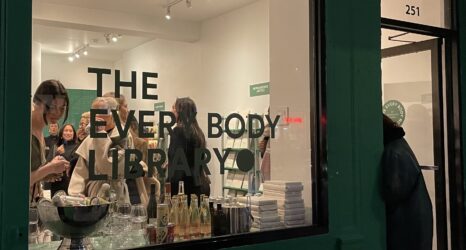“My passion for fashion can sometimes seem a shameful secret life,” wrote Princeton University English professor Elaine Showalter in 1997.
And indeed, after these words appeared in Vogue, more shame was heaped on her. Surely she must have “better things to do,” said one colleague.
Fashion, like so many other things associated primarily with women, may be dismissed as trivial, but it shapes how we’re read by others, especially on the levels of gender, class and race. In turn, how we’re read determines how we are treated, especially in the workforce—whether we are hired, promoted and respected, and how well we are paid. That most ordinary and intimate of acts, getting dressed, has very real political and economic consequences.
If feminists ignore fashion, we are ceding our power to influence it. Fortunately, history has shown that feminists can, instead, harness fashion and use it for our own political purposes.
When the rhetoric of equality fell on deaf ears, suffragists in the late 19th and early 20th centuries made quite literal fashion statements. Green, white and violet jewelry was a favored suffragist accessory, but not because of any aesthetic imperative: The first letters of each color— G, W, V—was shorthand for give women votes.
A century later, in the 1980s, women appropriated men’s styles of dress in an attempt to access the social and economic capital that lay on the other side of the glass ceiling. So-called career women practiced power dressing, wearing tailored skirt suits with huge shoulder pads, approximating the style and silhouette of the professional male executive.
Yet such adaptations of men’s fashion and styles are rarely without small feminine touches. Sociologist Jan Felshin coined the term feminine apologetic to describe how the pearls or ruffles on a woman’s professional attire serve as disclaimers: I may be powerful but I’m not masculine. Or (gasp!) a lesbian.
The fact that even the most politically and culturally commanding women must walk a razor’s edge between looking powerful and still appearing “appropriately feminine” underscores visual theorist John Berger’s concise description of mainstream society: “Men act and women appear.” In other words, men are judged by their deeds; women, by their looks.
In U.S. politics, Hillary Clinton has experienced the damned-if-you-do, damned-if-you-don’t double bind for strong women. If she wears a power pantsuit, it’s a “desexualized uniform,” but if she shows a hint of cleavage—as she famously did in 2007—it can ignite a media firestorm that eclipses her political platform.
While all women’s fashion choices are more carefully policed than men’s, women of color endure heightened scrutiny. Racist stereotypes that cast some women of color as “out of control” (the angry Black woman, the hypersexual Latina) and others as easily controllable (the traditional Asian woman, the sexually available Indian squaw) serve women poorly in the workplace. Professional women of color thus consciously and unconsciously fashion themselves in ways that diminish their racial difference. One Asian woman interviewed by sociologist Rose Weitz for the academic journal Gender & Society admitted that she permed her hair for work “because she felt that she looked ‘too Asian’ with her naturally straight hair.” A Black woman interviewed by Charisse Jones and Kumea Shorter-Gooden for their book Shifting: The Double Lives of Black Women in America explains that “she never goes into an interview or a new job experience without first straightening her hair. …‘I don’t want to be prejudged.’”
Away from the workplace, in everyday life, fashion policing of women is also racially stratified. Women of color who wear “ethnic dress” are often read as traditional, unmodern and, in some instances, conservative. When similar garments are worn by white women, they signify global cosmopolitanism, a multicultural coolness.
Fashion’s cultural appropriation is nothing new. Sally Roesch Wagner uncovered an earlier moment of appropriation in her book Sisters in Spirit, recounting the little-known history of the bloomer: the long baggy pants that narrowed at the ankles, usually associated with dress reformers in the mid-19th century. While prevailing fashion histories credit white New Yorker Elizabeth Smith (second cousin to Elizabeth Cady Stanton) with inventing the billowy pants and Amelia Bloomer with popularizing them, Wagner finds that Smith was influenced by Native Haudenosaunee women.
If fashion has been used to introduce new ways of expressing womanhood, it has also been a tether that keeps women’s social, economic and political opportunities permanently attached to their appearances. At a time when makeover reality TV shows suggest that self-reinvention is not only desirable but almost required, and the ubiquity of social media encourages everyone to develop a “personal brand,” the pressure on women to be fashionable has never been more pervasive. Even as the Internet has intensified the desire to be fashion-forward, it has also given outsiders unprecedented influence on the industry. In 2008, a fashion blog by an 11-year-old Midwestern girl named Tavi Gevinson went viral. Within two years, her reviews of new clothing lines were being closely followed by fashion movers and shakers, and famously aloof designers and editors invited Gevinson to their offices, runway shows and parties. Now a ripe old 15, she has used fashion as a springboard to her latest venture: editing an online teen magazine with a feminist point of view.
Today, fashion blogs that celebrate an array of non-normatively raced, gendered, sexed and sized bodies have emerged to challenge the dominant messages of gender, beauty and style. And bloggers are using their clout to speak out against offensive fashion and beauty products.
A blog-initiated campaign in 2010 convinced the cosmetics company MAC and the Rodarte design team to abandon their collection of nail polish and lipstick with names such as “Ghost Town,” “Factory” and “Juarez” (referencing the Mexican border town notorious for the serial murders of women working in local factories). Similar online campaigns have also been waged against designers and magazines that employ blackfacing and yellowfacing, as well as against retailers like Abercrombie & Fitch and American Apparel that perpetuate racist, sexist and sizeist beauty ideals. In the age of interactive social media, consumers have at least one ear of the fashion establishment; we should continue to speak up. Wearing fashion does not have to mean that we allow it to wear us down.
Excerpted from the Fall 2011 issue of Ms. To have this issue delivered straight to your door, join the Ms. community.
Comments on this piece? We want to hear them! Send to letterstotheeditor@msmagazine.com. To have your letter considered for publication, please include your city and state.
Read More:





